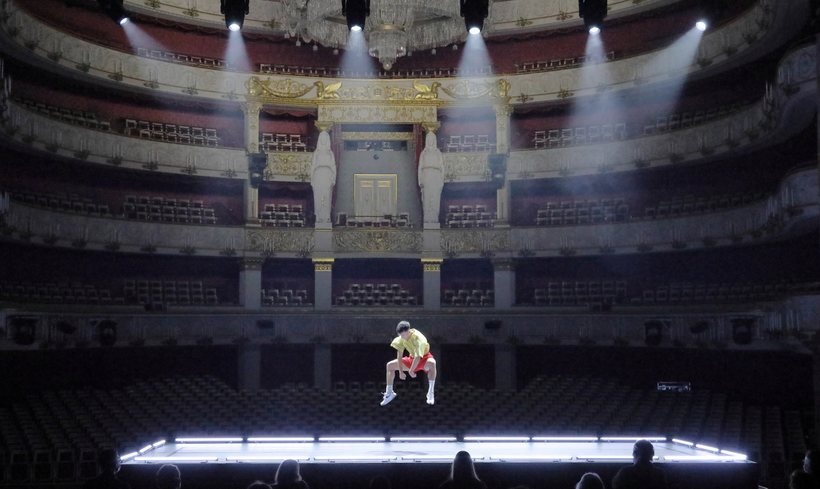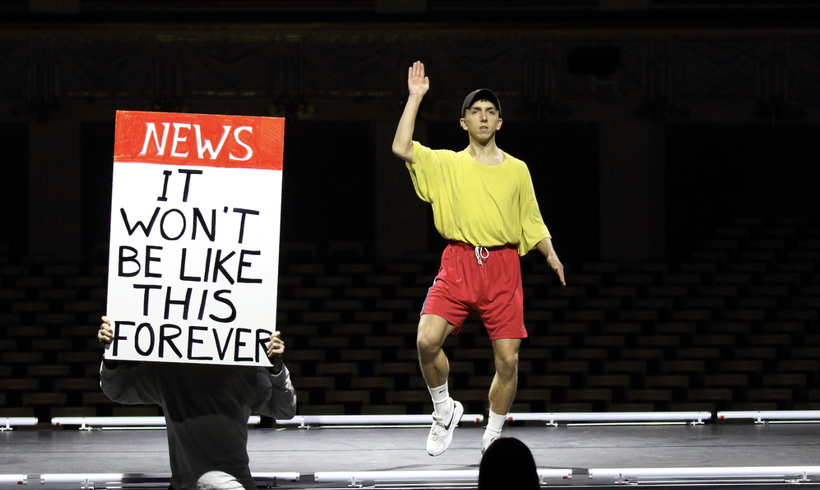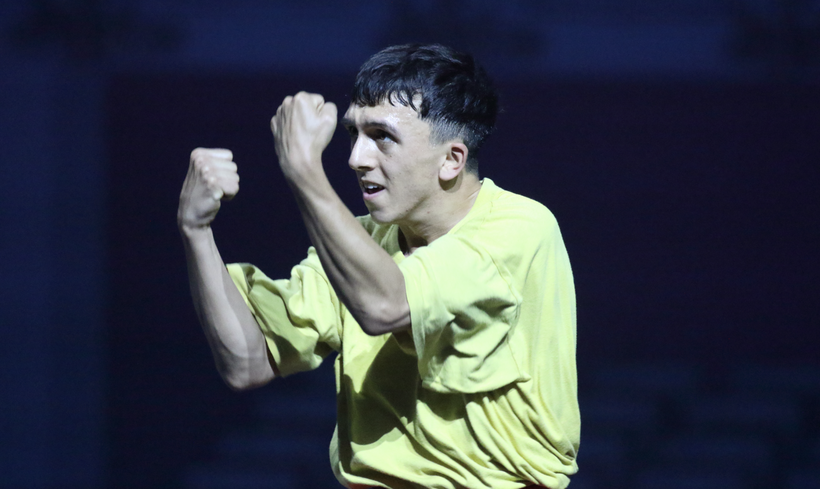Moritz Ostruschnjak: “I cannot make a piece without it being political per se.”
The Zero Point Festival brought to Prague the work Tanzanweisungen by German choreographer Moritz Ostruschnjak shortly after the same piece was presented at the Flora Theatre Festival in Olomouc. Ostruschnjak has attracted the attention of the professional community, with his works appearing, for example, on the German Dance Platform or in the prestigious selection of young choreographers at the Aerowaves Festival. Tanzanweisungen spea
What was your inspiration for Tanzanweisungen?
In terms of initial inspiration, there was simply none – because this piece was not planned at all. During the first lockdown, I was bored and annoyed by watching too much Netflix. Daniel Conant called me and told me the same. And approximately three days later, the producers of the Bayerische Staatsoper called me and offered me the place for my own creation. They couldn’t do anything with big groups, orchestra etc., so they needed small productions. By then, I already had a vague idea to make a solo piece for him, and we had more or less ten days to make a piece. So, this piece was not really planned at all – it was supposed to happen.
The inspiration came later. The piece reflects pandemic times, but also political tendencies, the division of society, usage and meaning of social media and internet in our lives, and so on.
What exactly do you mean by ‘politics’?
I don’t mean political as ideology by taking sides, but political as an artistic statement about the worlds nowadays. I think I cannot make a piece without it being political per se. Even if you consider social media and swiping through Instagram or TikTok: first, you have videos of lovely puppies or some funny prank, then comes the video of Russians bombarding Ukrainian villages.
The piece itself is physically very demanding. And as you said, it was made right after the corona lockdowns, so our bodies became atrophied and lazy in a way. How does the physicality connect to this matter?
That was my intention. After all performances being online without possibility of perceiving the physical body, I wanted to do deliberately something very physical, even exhausting. I wanted to make people feel the body of the performer. That is also why, most of the time, there is no music in Tanzanweisungen.
It is a fight. Daniel has to jump for 40 minutes – with only little breaks in between – and the first one comes after 12 or 13 minutes. First you see him being fresh, jogging with energy. After a while, you notice that his body and stage presence change. It is very straightforward – there is no bullshit about it.
There are many references to different dance and movements styles. How did this merging happen?
The piece is called Tanzanweisungen, which translates in English as Dance Instructions. I asked Daniel to collect various online videos from different sources and make a playlist out of them. It was important that each video included a moving body (not necessarily dance), because then I asked him to pick three seconds of each and we stitched them together. It is like a collage, all kinds of movement just laid next to each other. The idea was to copy the dramaturgy of social media, where you just swipe among broad variety of topics and videos. There are about 900 different references, and not a single step is original in the piece. We tried to take the on-line world and place it back in reality.
I was amazed at how seamlessly all those changes were made on stage in Daniel’s interpretation. I was drawn to the performance the same way as I am sometimes drawn to social media, losing track of my time.
My intention was to hold the attention of the audience, and that is why the content itself is very flashy. I wanted to try to use this logic of social media for dance.
People often ask why I didn’t pick the videos, but I was more interested in what Daniel comes up with. It speaks about him. It is a kind of browsing history, like a diary with which you could simply retrace your day. Sort of an on-line portrait. Each movement speaks of him, even though none of the material is originally his. There is nobody’s authorship, there are hundreds of authors.
During the performance, you come up with signboards titled News. One of them states: It won’t be like this forever. Is that a reference to media?
This is also stollen, I found it on-line from some Scottish artist.
So, even the graphic is copied?
Yes, the premise of the piece was not to do anything original. But this connects to the news, which is so vague that you can apply it to any situation at any time. Politics or corona, for example. Once when we performed it in Germany, it was the same day when the Mariupol theatre was destroyed by Russians, so people read this message accordingly. And this is what I like about those kinds of messages. They are sort of specific, but not. And we take this to the game. The point is that the audience will always complete the meaning.
What do you actually think about authorship? It has been a big topic lately, especially after the NFT’s launched by first soloist of the Royal Ballet, Natalia Osipova.
The internet changed lot of things; authorship included. It is definitely a tricky issue. But when you go back in history, the only way to learn dance is to copy someone else’s movements. Of course, I am not saying that stealing is correct, especially if you intend to become rich out of it, to be commercial, and to monetise it. But let’s face it – who will ever get rich from making contemporary dance?
I think that there is no original work, it simply does not exist. Something is always based on something else. I felt we had to radically copy everything. That is the political statement. I needed to maximize it and point at it in order to question it.
What is interesting is the historical dynamic of authorship – long ago, it was typical that a choreographer came with set of steps to teach, later on, a choreographer asked a dancer to come up with material. Now, you as a choreographer just transmit this to your dancer, who is dwelling upon someone else…
Exactly! That is the idea behind it – where is that authorship now? We don’t know. But the decisions you have to make by copying things and pasting them together are particularly interesting. You need to be very creative in order to do something “new” with it, to combine it, to go from one movement to another. These are all creative decision you must make during the process.
Also, you always change the context by extracting it from the original one (it can be costumes or music, etc.). It completely changes its meaning, so there lies some sort of creativity and originality, which comes through assembling other, pre-existing things. Not to go far and for better understanding – just consider the memes, which are extremely popular today. By extracting the original content and putting it to another context, it gets completely new connotations, which are super-funny.
But being copied may be seen as appreciation as well. Because, the better the art, the more you are copied. It is as simple as this.
When you talked about context, we saw an outdoor version of Tanzanweisungen. Did it change by taking it outside of theatre?
Yes, it does change. But there is one steady thing, which connects it to the original version – Daniel is always dancing on the higher platform, which symbolizes the big theatre stages. The original was made for the opera house, and an audience sat on the stage, so they could see the huge and empty auditorium behind the performer. That is a big reference to corona times.
But of course, overall, it changes. In theatre, the choreographer is God. You can make sunrise or sunset, you can make rain etc., but outside, you are normal human being.
Moritz Ostruschnjak
In his works Moritz Ostruschnjak dwells upon the transformations in physical and social experiences in times of digitization and virtualization. His pieces are spaces made up of hyperlinks, which utilize the media-machinery of the 21st century as a motif and an archive, thus mirroring and reflecting social processes.
As an active member of the graffiti-sprayer scene, Moritz Ostruschnjak developed his interest in contemporary dance through breakdancing. He studied at Iwanson International in Munich and completed his training with Maurice Béjart in Lausanne. He has been working as a freelance choreographer since 2013 and created the solo Island of Only Oneland and the ensemble pieces Text Neck, boids, Unster and Autoplay. His production Tanzanweisungen was selected for Tanzplattform Deutschland 2022 and for Aerowaves Twenty21 Artists. In 2022, he created his last piece called Terminal Beach.






